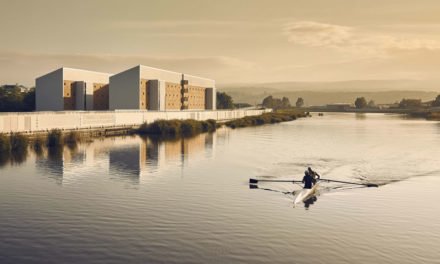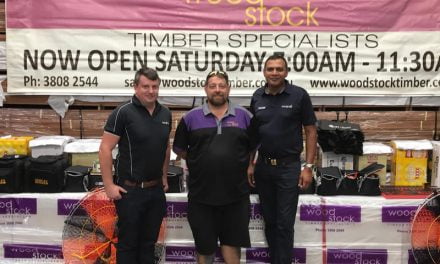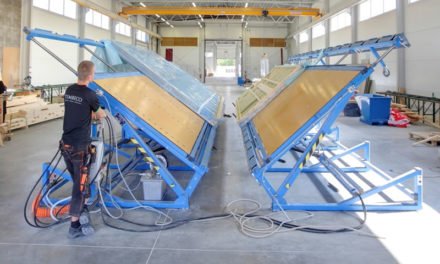It’s the best quality and most sustainable flooring, but there are problems to be solved. By Sharon and Ray Brice.
This month’s Brice on Boards column expands on April’s TTN cover feature on parquetry flooring. Parquetry focuses on timber sustainability and recycling. It’s a product long hailed as the cornerstone of the timber flooring industry and one on which the idea of timber’s status as a show of wealth, style and prestige was built.
April’s story touched on parquetry’s versatility and stability (it’s the least problematic of all timber flooring products) and its potential as a value-adding product for timber manufacturers, juxtaposed against the dying art of installing, sanding and finishing parquetry flooring given the dire lack of suitably skilled tradesmen.
Feeling passionate as we do about parquetry and its potential as an enduring timber flooring product, we thought we’d address some of the forest-to-floor challenges for the resurgence of parquetry as a commercially viable product.
The pressure on timber resources globally challenges us to use sustainable practices in the growth, development and use of timber products. In Brice on Boards TTN May 2014, we wrote that for this reason “there’s a lot of potential for the re-emergence of parquetry as the premier timber flooring product” since “historically the recovery rate in parquetry production utilises the majority of the designated feed stock in the manufacture of block and mosaic parquets”, making it a more sustainable and respectful use of timber resources compared to the recovery rate achieved in the production of structural or direct-stick strip floor boards.
But before we get too carried away with the idea of a parquetry resurgence or parquetry production as a value-adding exercise for timber mills, we should consider the previous cause of parquetry’s fall from grace. This was mostly down to the emergence and promotion of direct-stick floor boards, a product designed to provide the trending traditional floorboard look in homes with concrete floors. It is perhaps a little ironic that the timber flooring products that brought about the near extinction of the parquetry floor are the very products that have contributed to the strain on our timber resources.
Promoting parquetry
Parquetry as a value-adding product is a great way to recycle material considered waste from current core products while supporting timber sustainability. However, the viability of such strategies will depend on what the market can bear and without adequate promotion there will be nothing to drive demand. In our 2014 article we wrote “build it and they will come”. What we should have said is “promote it and they will come”.
The recent trends for Hamptons homes and bucolic provincial farmhouse kitchens have done little to raise awareness of the beautiful parquetry floors pivotal to the look. This is due in part to a lack of promotion in retail outlets, to the perceived inconvenience of the installation process and skills shortage, but most significantly due to the lack of ‘on trend focus’. However, timber floor innovations in the form of prefinished engineered floating parquetry floor modules, which lend themselves beautifully to the emerging minimalist and Scandi-inspired trends, seem set to reopen the door to traditional parquet flooring options and revitalisation of the diminishing skills vital to installation.
Engineered parquet modules are available as intricate panel designs, such as the very popular ‘Marie Antoinette’ or individual boards which can be laid to form many of the traditional parquet patterns; perhaps one of the most popular being the herringbone. The skills needed to set out this type of flooring are identical to those required for traditional parquetry, especially when the engineered elements are to be stuck to the substrate. On the other hand, sanding and finishing traditional parquet represents a different challenge.
Skills required
One might be forgiven for thinking that crossing the divide from sanding floorboards (e.g. strip flooring) to sanding and finishing parquetry is a small step, however there are some operational differences. Grain direction dictates the sanding strategy and parquetry floors are often intricately patterned, placing the grain in adjacent modules at differing tangents. This increases the potential for grain raise and sanding marks.
There are a number of publications that address the specifics of sanding and finishing parquetry, one being the Australian Standard AS 4786.2 – 2005 Timber Flooring Part 2: Sanding and finishing 2.3 Basic Sanding which states:
1 Basic sanding cuts are usually done at 45° to the grain direction as follows:
First cut at 45° to the grain direction.
Second cut at 90° to first cut.
2 For parquetry a further two cuts may be necessary, the third cut at 45° to the first cut and the fourth at 90° to the third.
The images atthe top of this page illustrate the correct and incorrect sanding strategy for herringbone parquetry.
The sanding and finishing of timber flooring, parquetry in particular is ‘one of those things’. It’s a very hands-on, learn on the job kind of deal, but, understandably, anyone who’s seen a novice sanding machine operator flung uncontrolled around a room or witnessed the disappearance of a drum sander as it sinks into the subfloor space would, with good reason, be wary of letting an unskilled person loose on someone’s nice parquetry timber floor.
It goes without saying that a level of formal training is required. While the mechanisms necessary to facilitate the upskilling or education of individuals interested in floor sanding and finishing are in place – LMFFL3604A (the government-endorsed training package) and the aforementioned standard AS 4786.2, 2005 – it would seem that finding a suitably qualified training provider (Registered Training Organisation) can be something of a challenge.
The problem is no doubt twofold. Training packages of this nature are run on a needs basis – put simply, bums on seats, and we lack suitably qualified trainers holding both a training qualification and an appropriate trade qualification with a great depth of skills knowledge and ability in the field. Which leaves the future of the industry in the untenable and precarious situation of relying on the intergenerational transmission of the skills and knowledge within industry families.
In South Australia the successful family-owned Parquetry Flooring Company Adelaide has come up with a strategy to future-proof the business beyond sharing skills and knowledge with children and staff. The owner actively participates in preserving industry skills and knowledge by providing interested candidates in his employ the opportunity to take an apprenticeship and earn the relevant trade qualification at TAFE SA.
TAFE SA offers Certificate111 in Flooring Technology National Code: MSF30813, TAFE SA Code: TP00693. The course is aimed at those wishing to acquire the skills and knowledge to work in the residential or commercial flooring technology sector of the furnishing industry. The package offers a comprehensive range of modules, including mandatories not specific to the timber flooring industry but fundamental to flooring trades in general, and a range of timber flooring-specific electives covering the installation, sanding and finishing of timber products.
All participants of the timber flooring industry can benefit from a comeback of parquetry from timber mills, wholesalers/distributors, sale reps, retailers, training organisations, installers and sanding and finishers, while maximising sustainability. As an industry let’s get behind parquetry and reap the benefits.
Ray and Sharon Brice specialise in mediation training and project management. They have four decades of experience in the flooring industry. Phone: 0407 591 697, email: rayandsharon@timbertradernews.com
Parquetry pictures supplied by Parquetry Flooring Company Adelaide.












